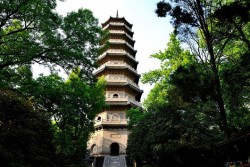

Introducing Linggu Temple
The Linggu Temple is a historic Buddhist temple located in Nanjing. Linggu Temple was once renowned as one of the greatest Buddhist temples in the world. Originally built during the Liang Dynasty (502-557 AD), the temple has been rebuilt multiple times, most notably after being destroyed during the Taiping Rebellion (1850).
Today, Linggu Temple remains a sacred site for meditation and worship, attracting devotees seeking solace and enlightenment. Beyond its spiritual significance, the temple holds deep historical meaning, serving as a memorial to the over 30,000 soldiers who perished in China’s Northern Expedition War (1926-1928). Furthermore, the revered Monk Xuanzang, famed for his epic journey to India to obtain Buddhist scriptures, rests within the temple grounds. His presence adds another layer of cultural significance to this cherished landmark, intertwining spirituality, history, and national memory.
Linggu Temple Fast Facts
• Chinese Name: Ling Gu Si 灵谷寺
• Religion: Buddhism
• Best Time to Visit: March to May; September to October
• Recommended Visiting Hours: About 1 to 2 hours
• Things to Do: Photography, History and Culture, Buddhism
• Opening Hours: 8:00 – 16:30
• Entrance Fee: CNY 35
• Address: No. 2 Linggusi, Xuanwu District, Nanjing, Jiangsu Province
What to expect at Linggu Temple
Beyond its traditional Buddhist halls, this temple complex is home to some truly unique treasures. Prepare to be amazed by the Wuliang Hall, a masterpiece of Ming Dynasty (1368-1644) architecture constructed without a single nail! History buffs won’t want to miss the Linggu Pagoda, a moving tribute to fallen soldiers. And for a truly spiritual experience, visit the Xuanzang Memorial Hall. Here, within a magnificent seven-tiered sandalwood pagoda, lies a portion of the skull bone of the famed Tang Dynasty (618-907) monk, Xuanzang.
Wangong Pond
South of the temple gate lies the Wangong Pond, also known as the Releasing Pond—a shimmering crescent of water stretching nearly 100 meters (328 ft) across. This tranquil oasis embodies a sacred tradition found in many Chinese temples: the practice of “fangsheng (放生),” or “releasing life.” Believed to cultivate good karma, this symbolic act involves gently releasing golden fish and turtles into the serene pond. This act of compassion, alongside the sight of creatures gliding peacefully through the water, invites reflection and a deep appreciation for the sanctity of all life.
Wuliang Hall
Wuliang Hall, also known as the Beamless Hall, stands as a testament to both architectural ingenuity and solemn remembrance. This sole surviving structure from the original Ming Dynasty temple complex miraculously withstood the ravages of war. Standing an impressive 22 meters (72 ft) high and 53.8 meters (176.5 ft) wide, the hall is a marvel of brickwork. Constructed entirely without wood or nails, its walls soar upwards, culminating in three graceful archways on both the front and rear facades. This unique building method earned the hall its name “Wuliang,” meaning “beamless.”
While originally a place of worship for Amitābha, the Buddha of Infinite Light (whose Chinese name resonates with “Wuliang”), the hall took on a new significance in 1931 and renovated in 1981. It was transformed into a memorial cemetery to honor the over 30,000 soldiers who made the ultimate sacrifice during the Northern Expedition War (1926–1928).
Linggu Pagoda
Visible from afar, the Linggu Pagoda is a striking nine-story structure towering 60.5 meters (198 feet) high. Designed by American architect Henry K. Murphy and completed in 1929, it serves as a tribute to fallen soldiers. Inside, the pagoda’s walls bear inscriptions of speeches and epigraphs by former presidents of the Republic of China, as well as the names of countless martyrs from the Revolution of 1911 to the Northern Expedition.
Xuanzang Memorial Hall
Within the Mahavira Hall, the eastern wing houses the Xuanzang Memorial Hall, a tribute to one of China’s most revered Buddhist figures. Established in 1973, the hall commemorates the life and legacy of Master Xuanzang, also known as the Tripitaka Master. At its heart stands an exquisite seven-tiered, six-sided pagoda, crafted from fragrant sandalwood. With its gracefully curved eaves and corners adorned with delicate peach motifs, the pagoda is a masterpiece of religious architecture. It serves as a reliquary, safeguarding a precious relic – a fragment of Xuanzang’s skull bone – a tangible reminder of the great monk’s extraordinary journey and enduring impact on Buddhism.
How to get to Linggu Temple
• By Bus: Take bus 202 to Linggusi gongyuan Station.
• Rent a car/bus from GGC to enjoy a hassle free private transfer from hotels in Nanjing to Linggu Temple.
Additional travel advice on Linggu Temple
• Visitors can go to nearby attractions (Sun Yatsen Mausoleum, Ming Xiaoling Mausoleum, etc.) by sightseeing bus, battery car or small train.
• Please keep quiet in the temple.